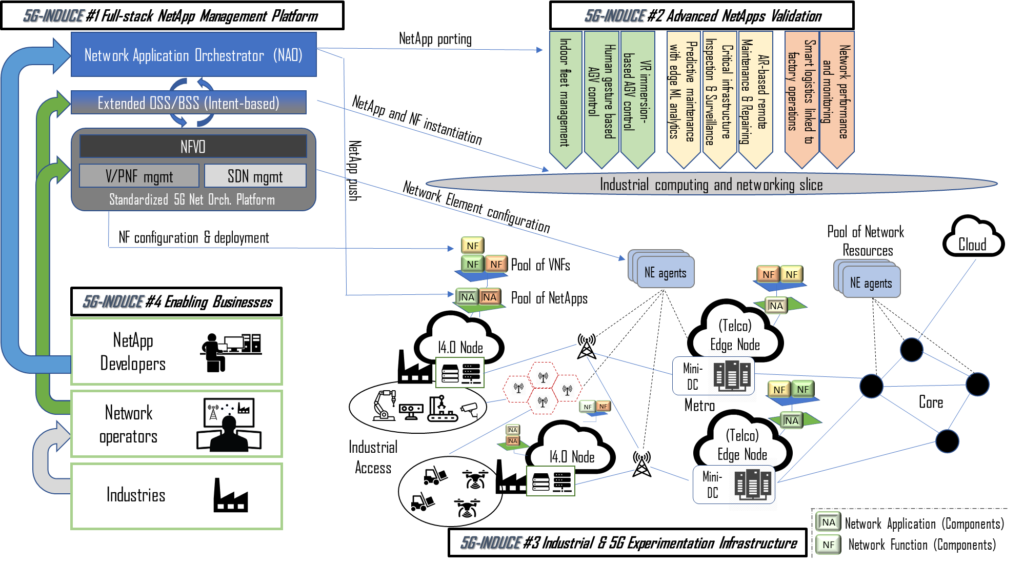Vision and Goal
The vision of 5G-INDUCE is to provide an end-to-end orchestration platform for 5G applications that can be easily ported, deployed and managed, showcasing advance 5G trial use cases, with demonstrable performance metrics that conform to specific KPI requirements. The overall demonstration effort should lead to both technological and business validation of 5G technologies in the context of specific smart industrial services.
The 5G-INDUCE project aims at building the enabling open and cooperative 5G network platforms that will allow the showcasing and evaluation of advanced network applications Network Applications), developed primarily by innovative SMEs, supporting emerging, as well as innovative services related to the industry 4.0 environment.
The project is based on the solid know-how and the complete 5G application and network orchestration platforms from successfully demonstrated 5GPPP research activities and combines them with already deployed and mature 5G experimentation infrastructures, interconnected with private infrastructures from the industry sector.
The goal is to provide realistic experimentation facilities for the seamless deployment of network functions, forming the building blocks of market oriented industrial Network Applications, while providing an attractive platform for service providers seeking to advance the TRL of their network functions and Network Applications to 7 before commercialization.
Architecture
5G-INDUCE integrates state of the art solutions for the development of a complete Network Application orchestration platform composed of:
- a Network Application Orchestration (NAO) framework, interfacing with the end users and serving their Application requirements and
- a NFV Orchestration (NFVO) framework that manages the distributed resources over the virtualised infrastructure.
In this architecture, the network management part is typically owned by the telecom operator, which is reluctant to expose any infrastructure details to end users; however, end users require such information for optimised application deployment. Therefore, an intelligent Operations Support System (OSS) is typically required in the middle and provides the interface that translates Application requests into Network connectivity and resource allocation requirements. The NAO is integrated with the OSS extending its capabilities to the interfacing with the vertical end users and the application developers, while operators gain the ability to apply polices and any intelligent data analytics methodology at the service layer. Such a scheme maintains the edge resource management capabilities of the standardised ETSI NFVO framework, while enabling an application-oriented network management and optimisation approach.

The overall 5G-INDUCE system architecture follows a four-axis structure, as depicted in figure above. These four axes highlight the core activities of the project:
- Axis #1 – Full-stack Network Application Management Platform: Takes state-of-the-art research technologies, developed and tested in previous 5G PPP research project initiatives, to a substantially higher technology-readiness level required by the Industry 4.0 standards, while at the same time offering the first ecosystem for advanced overlay 5G Network Applications. Specifically, the 5G-INDUCE platform integrates state-of-the-art control and data plane developments ranging from industrial IoT devices and 5G radio access nodes to a state-of-the-art OSS and a scalable microservices-based cloud orchestration platform, each with a clear evolution roadmap towards an integrated full-stack 5G Network Application management platform.
- Axis #2 – Advanced Industry 4.0 Network Applications: Showcasing the support of a variety of innovative Industry 4.0 market verticals through the demonstration of advanced use cases, meeting demanding Industry 4.0 and 5G KPIs, such as ultra-low latency, fast service deployment, high service reliability, while accommodating industrial-grade scalability demands.
- Axis #3 – Industrial & 5G Experimentation Infrastructure: Heterogeneous real-world industrial fields at scale provided by both global (with active presence in Europe) and European industrial players, on key industrial sectors, such as automotive, energy, and home appliances. 5G-INDUCE partners the aforementioned industrial players together with large European mobile network operators and vendors, aiming to build a unique fabric of tightly interconnected 5G infrastructures with industrial fields, which will lead the Industry 4.0 activities in Europe. Prior to the deployment of 5G-INDUCE Network Applications on the real experimentation infrastructure, 5G-INDUCE utilizes a state-of-the-art 5G platform integrator and Network Application DevOps testbed for pre-deployment testing and validation.
- Axis #4 – End Users (Enabling Businesses): Creates huge impact for key market stakeholders through a win-win-win (win3) business model that generates mutual benefits for (i) industrial players, (ii) network operators, and (iii) a large pool of heterogeneous SMEs/start-ups acting as Network Application developers, while maintaining discrete and distinct roles for each of these stakeholders.

